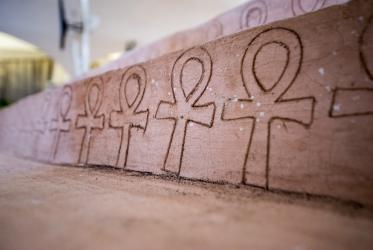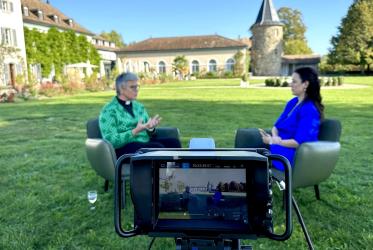By Odair Pedroso Mateus *
A few days later the Archbishop of York was in Edinburgh for the second world conference of the ecumenical movement on Faith and Order, an amazing constellation of eastern Orthodox hierarchs and western Protestant and Anglican professors engaged in theological work for reconciliation between Christian churches. As the leader of Faith and Order, he was busy supervising the very final preparations for the conference, thinking about a sermon and a presidential address he had to deliver in the following days, and welcoming 443 delegates from 122 Christian churches or denominations in 43 countries.
On 3 August, Temple preached at the conference opening service at the “Presbyterian Cathedral” of Saint Giles. No rest after that. In the following days, an incident with racial connotations, involving his African-American colleague Bishop William Heard, required immediate response. And on top of all that, the archbishop was concerned with mounting fear and resistance within the Movement on Faith and Order to the proposal to bring Life and Work and Faith and Order under the roof of a future World Council of Churches.
“We could not seek union if we did not already possess unity”
Temple’s sermon on 3 August, on Ephesians 4:13, could be read as an outline of the emerging ecumenical vision. Seen in hindsight, the choice of Ephesians was no surprise. That letter, with its future-oriented vision of unity centred on the cosmic, reconciling power of Christ’s cross, would become a kind of “canon within the canon” in future Faith and Order work until the recent The Church: Towards a Common Vision.
The unity of the church, Temple launched at the outset, “is grounded in the unity of God and the uniqueness of His redeeming act in Jesus Christ.” Thus, our task is not to create it. “We could not seek union if we did not already possess unity.” However, the church, in its present state of division in history, is like a lantern covered with a dark veil. It is truly a lantern, yet “the world may see the sin of Christians more clearly than the holiness of the church, and the divisions which that sin has caused more clearly than the unity which endures in spite of them.”
And he asked: How can the church claim to bridge the divisions in human society, “if when men are drawn into it they find that another division has been added to the old ones – a division of Catholic from Evangelical, of episcopalian from Presbyterian or Independent?” Through division we have obscured our witness to the gospel and lost “some spiritual treasure” given to others.
After celebrating the ecumenical achievements following the 1927 world conference, the Archbishop of York concluded by challenging the conference participants to open themselves to the Spirit and grow to full perfection in Christ: “It is only by coming closer to him that we can come nearer to one another.”

The Archbishop Germanos, The Archbishop of York, William Temple, and the Moderator of the Church of Scotland at the World Conference on Faith and Order, Edinburgh, 1937
Hotel accommodation refused to black American Bishop William Heard
It was time to address the incident involving his Faith and Order friend William Heard. Born into slavery in 1850, the young William fell in love with education at Sunday school. Restrictions imposed on black people’s access to education did not break his resolve to learn. He studied at the University of South Carolina and later on in Philadelphia. He was elected to the senate of South Carolina in the late 1870s and in the 1890s he was US consul general in Liberia. The African Methodist Episcopal Church ordained him in 1883 and elected him bishop in 1908. Heard was a delegate to the first world conference on Faith and Order, held in Lausanne in 1927, and subsequently a member of its Continuation Committee until 1937.
Aged 88—the most senior delegate at the Faith and Order conference—Bishop Heard had registered for the conference and rooms had been reserved for him and his grand-niece, the lawyer Valerie Caldwell, at Edinburgh Hotel. They learned on arrival that the reserved rooms were no longer available due, according to the hotel, to overbooking. The incident made the news. The Scotsman of 9 August titled “Alleged ‘Colour Bar.’ ” Chancellor John Simon, the British minister of finances, and his wife, who had authored a book supporting the abolition of slavery, met with Heard and Caldwell to express their sympathy. Temple offered them accommodation at Cowan House, where he was staying during the conference.
Temple was in the chair when the conference convened in plenary session on 4 August at 10 am. The first point in the agenda was the adoption of the rules of procedure for the conference. That was easily done. The second was the proposal to bring the movements on Life and Work and Faith and Order under the same roof of a global fellowship of churches. The time had come.
Between economic crisis and national socialism: the long and winding road that led to the World Council of Churches
Temple may have recalled for a short moment the day in 1933 when, encouraged by William Adams Brown from Union Theological Seminary and the Movement on Life and Work, he had hosted at Bishopthorpe, south of York, an informal consultation of leaders of different ecumenical movements to brainstorm on the pressing issue of a viable future for them and, particularly, for the movements on Life and Work and Faith and Order.
The two movements had been hit by the global economic crisis of the early 1930s. The Boston-based Faith and Order, which had opened an office in Geneva in 1930, was forced to close it in 1933. Its Continuation Committee cancelled its 1932 and 1933 meetings for budget problems. Its theological committee was unable to start a planned study on the sacraments and the publication of the churches’ responses to the 1927 conference was postponed sine die. Ralph W. Brown, the movement’s general secretary, resigned early in 1933. Leonard Hodgson, the theological secretary, added Brown’s work to his own and his house in Winchester became the new official address of the Faith and Order Secretariat. How would Faith and Order pursue its ecumenical theological mission?
Other reasons spoke in favour of greater institutional coordination in the work of the two movements. Unlike other ecumenical movements, both were church-based and shared a similar constituency. Both had realised in recent years that they were increasingly complementary: After 1925, Life and Work felt the need to give greater theological depth to its practical agenda while during the 1930s, Faith and Order gained progressively the awareness that the origin of church divisions and the search for church unity could not be confined to issues of doctrine and ordained ministry alone as they were also a matter of “non-theological factors.”
In the two years following the 1933 Bishopthorpe consultation, the project of establishing a World Council of Churches gained momentum as the Confessing Church in Germany struggled against the attempts of the Nazi regime to submit the church to its nationalist, racial and totalitarian agenda. The struggle of the Confessing Church raised radical questions about the spiritual and ecclesial self-understanding of the two ecumenical movements. If they understood themselves as Church of Christ, they had to struggle with the fundamental question of being the Church in times of paganism and consequently with crucial questions such as the distinction between true and false church and solidarity with persecuted minorities.
In the northern summer 1936, meeting near Montreux, on the postcard shores of the Lake of Geneva, the Continuation Committee of Faith and Order received a series of reports and resolutions from a US meeting of ecumenical leaders and from Life and Work on possible steps to be taken towards the urgent reconfiguration of the ecumenical movement. “Considerable discussion took place on the questions raised by these reports and resolutions” noted the minute taker of the meeting, suggesting hesitation, if not opposition, to the idea of embarking Faith and Order in an institutional adventure with a movement (Life and Work), whose members believed that “doctrine divides, but service unites,” and increasingly aligned themselves with the German Confessing Church in opposition to the “official” German Evangelical Church, whose leadership opposed the growing influence of Life and Work on the ecumenical movement.
The Continuation Committee finally agreed with the other ecumenical movements on “the appointment of a committee to review the work of ecumenical cooperation since the Stockholm and the Lausanne Conference, and to report to the Oxford and Edinburgh Conferences regarding the future of the ecumenical movement.” Concerned with its autonomy and relations with official churches, Faith and Order noted diplomatically that after its upcoming 1937 world conference, the future of the movement would rest entirely “in the hands of the officially appointed representatives of churches there assembled” (meaning: and not in the hands of any another ecumenical organisation…)
A race against time was launched. The committee in charge of proposing a reconfiguration of the ecumenical movement—later known as the Committee of the Thirty-Five—had to be appointed in the following months through a complex process of consultation with churches, councils of churches, Faith and Order, Life and Work, the World Alliance for Promoting International Friendship Through the Churches, the International Missionary Council, the World Student Christian Federation, the Young Women’s Christian Association, and the Young Men’s Christian Association. It would have to meet and develop a detailed proposal to be submitted the latest by mid-July 1937 to the Oxford World Conference on Life and Work and early in August to the World Conference on Faith and Order.
The Committee of the Thirty-Five finally met in London, 8-10 July 1937, just a few days before the Oxford World Conference. Three of its members – the Germans Hanns Lilje, Reinold von Thadden, and Wilhelm Zoellner were refused permission to attend the meeting. The committee managed in two-and-a-half-days to accomplish its mission. The Life and Work World Conference, meeting under the anti-totalitarian theme “Church, Community and State,” approved the committee’s report and the proposal to form a World Council of Churches and forwarded it and its decision to Faith and Order in Edinburgh.

Group of American delegates at the World Conference on Faith and Order, Edinburgh, 1937 (where Bishop Heard can be seen too)
Faith and Order “intends to be married and with equal determination to remain single.”
Temple, as you may remember from nine paragraphs ago, was in the chair on 4 August at 10 am. The chairman introduced the report from the Committee of Thirty-Five but did not open a discussion on its proposals. He referred it immediately to a special committee of 60 members, appointed to consider it and report in plenary one week later. On 11 August at 20:30, the special committee reported. Its recommendations concerning the next steps towards placing Faith and Order and Life and Work under a World Council of Churches were a “yes, but…”
Yes, Faith and Order and Life and Work should move to appoint a Constituent Committee to complete the plans for a World Council of Churches and convene its first assembly when plans would be approved by the churches. But the Continuation Committee would give its final approval to the complete plan in 1938 “only if the following guarantees be incorporated:” the future WCC “Commission on Faith and Order” will be the Continuation Committee appointed by the Edinburgh World Conference; any further WCC appointments to the Commission on Faith and Order shall be of persons from churches “which accept our Lord Jesus Christ as God and Saviour;” the Faith and Order Secretariat will be appointed by the commission “in consultation with the Council;” the World Council “shall consist of official representatives of the Churches participating.”
Discussion followed. J. Ross Stevenson had introduced the report by warning that “we are facing a world situation quite different from that in which the Faith and Order movement began.” Faith and Order “is no longer a unique and interesting new venture for which financial and other support can easily be secured… it must adjust itself to the changed situation.” Temple noted that the proposal in deliberation had two main objects: to make it easier to interest the public in the world movement of the churches and to associate the churches more closely together so that they would be drawn into unity.
Archdeacon Alfred E. Monahan, of the Church in Wales, was initially afraid that Faith and Order would abandon its trinitarian theological basis and adopt the unitarian basis of some members of Life and Work. He did not see the need for a WCC. However, “as so many better men are in favour of it and no vital principles are involved, I intend to vote for the approval of this report.” Liu Tingfang (T. T. Lew), representing the “younger churches,” noted that in China people often asked him about closer cooperation between Faith and Order and Life and Work: “If this report is approved, it will lead to a great increase of interest in Faith and Order in China.” The report was approved with one voice in opposition.
Three days later the proposal to establish a World Council of Churches was back in plenary, this time through the report of Section IV on “The Church’s Unity in Life and Worship.” The Anglican Arthur C. Headlam, bishop of Gloucester, asked for the floor. “I am sorry, but I wish to record my opposition to the proposal for the creation of a World Council of Churches in the last paragraph of the Report. I do not know how many there are who are opposed to it, but there is a definite body of members of the Conference who are opposed to this idea, and many opposed to any definite connection with the Life and Work Movement. If such a Council were to exist, and if it passed resolutions on public affairs, it might do a considerable amount of harm.”
Headlam’s views were aligned with those of the leadership of the German Evangelical Church and with those of the Methodist J.W.E. Sommer and the Old Catholic Bishop Erwin Kreuzer who declared in plenary on 6 August: “We do not believe that the modes of life growing up on the basis of the totalitarian state in its actual existence, which have brought to our country and nation [Germany] new courage, unity and strength, are necessarily opposed to the gospel.”
The Faith and Order Continuation Committee met one year after those 30 days that had changed the modern ecumenical movement. A new round of discussions yielded in agreement with the new draft of the WCC Constitution, which protected the autonomy of Faith and Order. Bishop Headlam once again voted against, foreseeing the end of Faith and Order. He wrote to Bishop Theodor Heckel, head of the Foreign Office of the German Evangelical Church: “We have not been successful in preventing the World Council…” Joseph Oldham wrote to W. A. Visser ‘t Hooft, the first general secretary of the WCC: “the Faith and Order movement intends to be married and with equal determination to remain single.”
* Odair Pedroso Mateus was director of the WCC Commission on Faith and Order (2015-2022), WCC deputy general secretary (2020-2022) and professor of ecumenical theology at the WCC Ecumenical Institute at Bossey, Switzerland (2004-2021).
The author dedicates this text to Anne-Emmanuelle Tankam-Tene, WCC Archives, in recognition for her service to ecumenical research.






